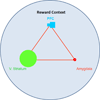Neural systems underlying motivated behavior in adolescence: implications for preventive medicine
- PMID: 22198622
- PMCID: PMC3480556
- DOI: 10.1016/j.ypmed.2011.11.016
Neural systems underlying motivated behavior in adolescence: implications for preventive medicine
Abstract
Objective: Although a time of increased independence and autonomy, adolescence is also a time of vulnerabilities, through increased risk-taking and the emergence of psychopathology. Neurodevelopmental changes during this period may provide a neurobiological basis for this normative rise in deleterious behaviors. Thus, the objective of this review was to identify neurodevelopmental processes underlying the emergence of risk-taking and psychopathology in adolescence, and discuss implications of these findings for prevention.
Method: This article reviews literature examining developmental and contextual factors influencing neural functioning in systems mediating threat, reward, and cognitive control. This literature is discussed from the perspective of the Triadic Neural Systems Model of motivated behavior.
Results: Neuroimaging research suggests that neurodevelopmental and contextual factors both contribute to a shift in the functional equilibrium among the Triadic nodes. This equilibrium shift may contribute to negative outcomes of adolescent risk behavior. Most importantly, the balance of this equilibrium and its sensitivity to social and appetitive contexts may be exploited to facilitate prevention of deleterious outcomes.
Conclusion: Understanding developmental and contextual factors that influence functioning in motivational neural circuits can inform research on adolescent risk-taking, and may provide targets for novel preventions, for example through the use of incentives to reduce deleterious outcomes.
Copyright © 2011 Elsevier Inc. All rights reserved.
Conflict of interest statement
The authors declare that there are no conflicts of interest.
Figures




Similar articles
-
Cerebral maturation in adolescence: behavioral vulnerability.Encephale. 2009 Dec;35 Suppl 6:S182-9. doi: 10.1016/S0013-7006(09)73469-4. Encephale. 2009. PMID: 20141770 Review.
-
Neurobiology of the development of motivated behaviors in adolescence: a window into a neural systems model.Pharmacol Biochem Behav. 2009 Sep;93(3):199-211. doi: 10.1016/j.pbb.2008.12.013. Epub 2008 Dec 24. Pharmacol Biochem Behav. 2009. PMID: 19136024 Review.
-
The triadic systems model perspective and adolescent risk taking.Brain Cogn. 2014 Aug;89:114-5. doi: 10.1016/j.bandc.2013.11.001. Epub 2013 Dec 8. Brain Cogn. 2014. PMID: 24321346
-
The triadic model perspective for the study of adolescent motivated behavior.Brain Cogn. 2014 Aug;89:104-11. doi: 10.1016/j.bandc.2014.01.006. Epub 2014 Feb 17. Brain Cogn. 2014. PMID: 24556507 Free PMC article.
-
Within-subject neural reactivity to reward and threat is inverted in young adolescents.Psychol Med. 2017 Jul;47(9):1549-1560. doi: 10.1017/S0033291716003111. Epub 2017 Feb 27. Psychol Med. 2017. PMID: 28238294 Free PMC article.
Cited by
-
Design and methods of a randomized web-based physical activity intervention among children with cancer: A report from the Children's Oncology Group.Contemp Clin Trials. 2022 Nov;122:106961. doi: 10.1016/j.cct.2022.106961. Epub 2022 Oct 10. Contemp Clin Trials. 2022. PMID: 36228982 Free PMC article. Clinical Trial.
-
Considerations for imaging the adolescent brain.Dev Cogn Neurosci. 2012 Jul;2(3):293-302. doi: 10.1016/j.dcn.2012.02.002. Epub 2012 Feb 27. Dev Cogn Neurosci. 2012. PMID: 22669033 Free PMC article. Review.
-
Executive functioning moderates neural reward processing in youth.Cogn Affect Behav Neurosci. 2021 Feb;21(1):105-118. doi: 10.3758/s13415-020-00851-z. Epub 2020 Dec 2. Cogn Affect Behav Neurosci. 2021. PMID: 33263153 Free PMC article.
-
Executive functioning moderates neural mechanisms of irritability during reward processing in youth.Psychiatry Res Neuroimaging. 2022 Jul;323:111483. doi: 10.1016/j.pscychresns.2022.111483. Epub 2022 Apr 17. Psychiatry Res Neuroimaging. 2022. PMID: 35561577 Free PMC article.
-
Application of Research Domain Criteria to childhood and adolescent impulsive and addictive disorders: Implications for treatment.Clin Psychol Rev. 2018 Aug;64:41-56. doi: 10.1016/j.cpr.2016.11.003. Epub 2016 Nov 9. Clin Psychol Rev. 2018. PMID: 27876165 Free PMC article. Review.
References
-
- Amodio DM, Frith CD. Meeting of minds: the medial frontal cortex and social cognition. Nat Rev Neurosci. 2006;7:268–277. - PubMed
-
- Arnett JJ. Adolescent storm and stress, reconsidered. Am Psychol. 1999;54:317–326. - PubMed
-
- Brewer JA, Sinha R, Chen JA, Michalsen RN, Babuscio TA, Nich C, Grier A, Bergquist KL, Reis DL, Potenza MN, Carroll KM, Rounsaville BJ. Mindfulness training and stress reactivity in substance abuse: results from a randomized, controlled stage I pilot study. Subst Abus. 2009;30:306–317. - PMC - PubMed
Publication types
MeSH terms
Grants and funding
LinkOut - more resources
Full Text Sources
Medical

